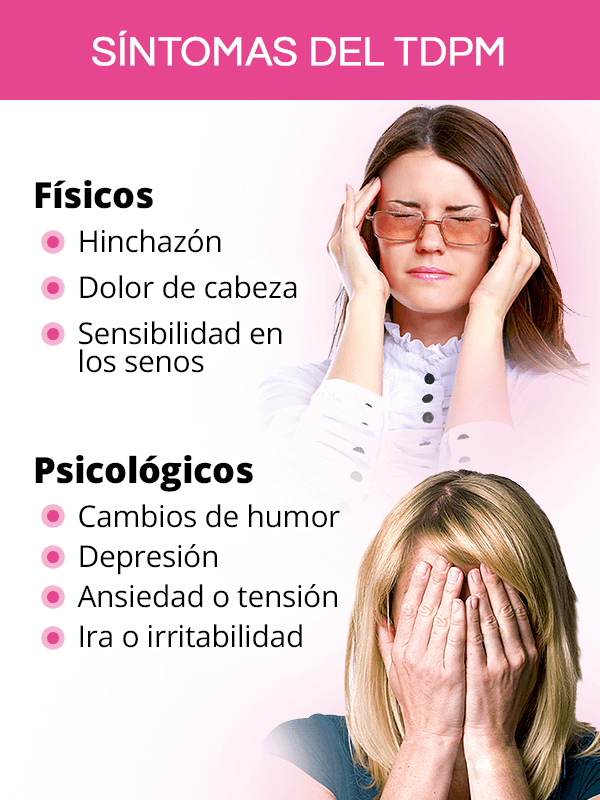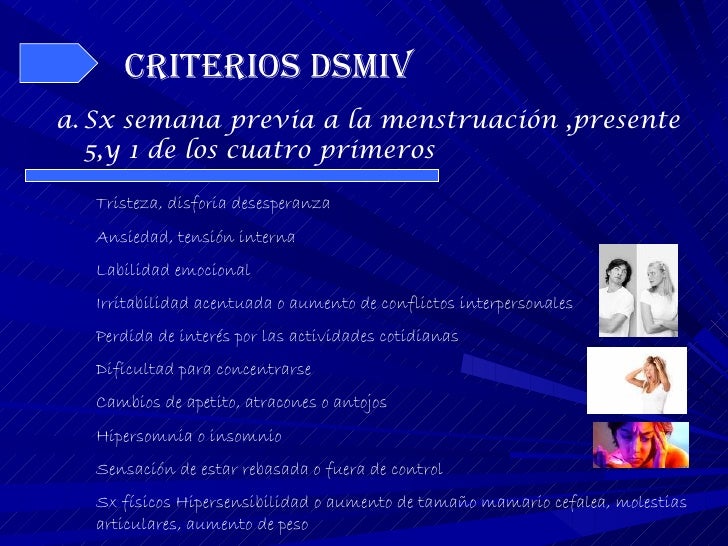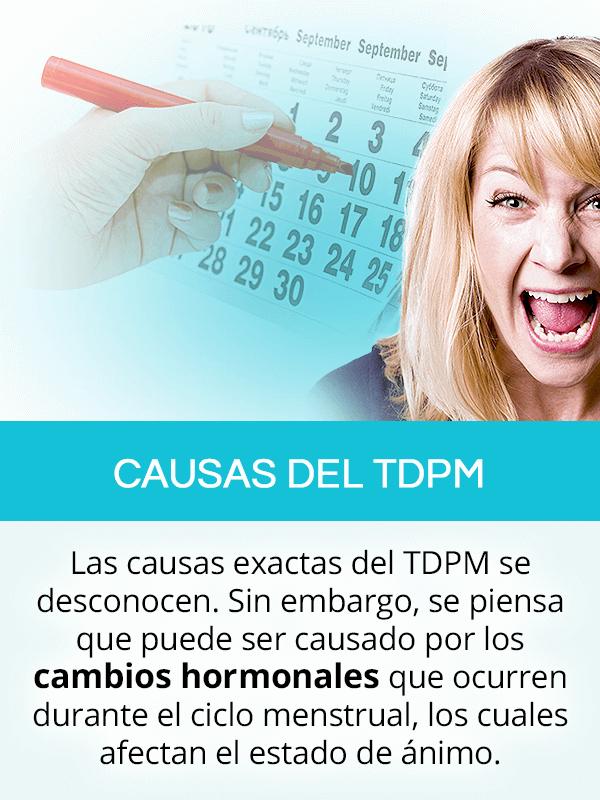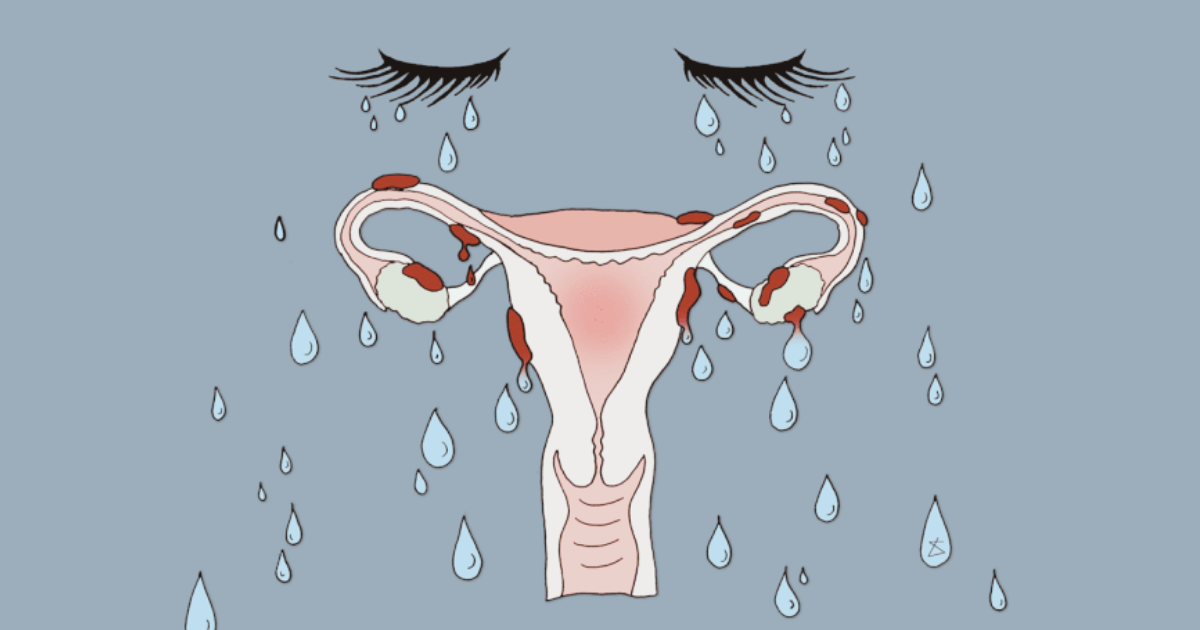
Trastorno Disfórico Premenstrual Qué Es, Síntomas Y Tratamiento 88.9FM RDSRadio
El trastorno disfórico premenstrual (TDPM) es una forma mucho más severa del síndrome premenstrual (SPM). No se conoce la causa exacta del TDPM. Los síntomas principales que diferencian al TDPM de otros trastornos del estado de ánimo o afecciones menstruales es cuándo comienzan los síntomas y cuánto duran. Los síntomas del TDPM son tan.

Trastorno Disfórico Premenstrual (TDPM) SheCares
Premenstrual symptoms include a constellation of mood, behavioral, and physical indications that occur in a cyclic pattern prior to menstruation and then wane off after the menstrual period in women of reproductive age.

TRASTORNO DISFÓRICO PREMENSTRUAL (TDPM) Instituto PsicologíaSexología Mallorca
A screening instrument for diagnosing premenstrual dysphoric disorder is proposed. • The instrument has been developed by using the seven diagnosing criteria of DSM-5. • Its two dimensions, Dysphoria and Apathy, have good internal consistency. • The instrument has shown acceptable reliability and validity. Abstract Methods Conclusion Keywords

Manifestaciones Clínicas y Diagnóstico Del Síndrome Premenstrual y El Trastorno Disfórico
In fact, and in accordance with current calculations, premenstrual dysphoric disorder is suffered by between 3% and 10% of the population; in the study done by Aperribai, by contrast, it has been found to affect 15%. The author has explained that this difference is "normal because it concerns test screening.

Trastorno disfórico premestrual causas, diagnóstico y tratamiento mediQuo
Premenstrual dysphoric disorder, which affects 2%-5% of premenopausal women, was included in Appendix B of DSM-IV, "Criterion Sets and Axes Provided for Further Study."

SÍNDROME PREMENSTRUAL TRASTORNO DISFÓRICO PREMENSTRUAL Diagnóstico, síntomas, causas y
What is PMDD? Premenstrual Dysphoric Disorder. | IAPMD NEW ACOG Clinical Practice Guideline for Premenstrual Disorders | Read IAPMD position statement » PMDD Linked to Gene Network From a US national research authority Watch on The episode was not found or is unavailable. What is PMDD [Premenstrual Dysphoric Disorder]? Watch on

Trastorno Disfórico Premenstrual (TDPM) SheCares
The symptoms of PMS and PMDD are: Sadness and crying. Feeling nervous or anxious. Anger or irritability. Strong cravings for certain foods. Problems paying attention and concentrating. Fatigue. Physical problems such as breast tenderness, headaches, joint or muscle pain, and swelling or bloating. Trouble sleeping.

¿Qué es el trastorno disfórico premenstrual? Child Mind Institute
Según la visión de Aperribai, el manual le da al trastorno disfórico premenstrual una identidad especial, a pesar del hecho de que todavía está clasificado entre aquellos descritos como "trastornos depresivos no especificados," así que constituye una propuesta firme al tomar los principales grupos de síntomas en consideración.

Así Son Los Síntomas Del Trastorno Disfórico Premenstrual PDF Manual Diagnóstico y
Premenstrual dysphoric disorder (PMDD) is a condition in which a woman has severe depression symptoms, irritability, and tension before menstruation. The symptoms of PMDD are more severe than those seen with premenstrual syndrome (PMS).

TRASTORNO DISFÓRICO PREMENSTRUAL qué es, síntomas, causas y tratamiento
Premenstrual disorders consist of psychiatric or somatic symptoms that develop within the luteal phase of the menstrual cycle, affect the patient's normal daily functioning, and resolve shortly.

Trastorno disfórico premenstrual
Diagnosis. About 80% of women report at least mild premenstrual symptoms, 20%-50% report moderate-to-severe premenstrual symptoms, and about 5% report severe symptoms for several days with impairment of functioning. 1 The 5% of women with the severest premenstrual symptoms and impairment of social and role functioning often meet the diagnostic criteria for premenstrual dysphoric disorder (PMDD).

Trastorno disfórico menstrual ¿qué es y cómo reconocerlo? Tucuman24
Premenstrual syndrome (PMS) and premenstrual dysphoric disorder (PMDD) are common disorders of the luteal phase of the menstrual cycle and are characterized by moderate to severe physical, affective, or behavioral symptoms that impair daily activities and quality of life.

Trastorno disfórico premenstrual y sus graves consecuencias
El síndrome premenstrual (SPM - PMS por sus siglas en inglés) es una enfermedad médica que afecta a algunas mujeres de edad fértil. Más de una de cada tres mujeres sufre de SPM, y una de cada 20 sufre tan severamente que sus vidas se ven seriamente afectadas. El SPM está relacionado con una variedad de síntomas físicos o psicológicos.

Trastorno Disfórico Premenstrual (TDPM) SheCares
Methods: The Premenstrual Dysphoric Disorder Questionnaire for DSM-5 (Cuestionario del Trastorno Disfórico Premenstrual - DSM-5), a 25-item questionnaire to assess PMDD was developed and.

Trastorno disfórico premenstrual
El TDPM causa irritabilidad severa, depresión o ansiedad durante una o dos semanas antes del inicio del período menstrual. Los síntomas suelen desaparecer dos o tres días antes del inicio del período menstrual. Es posible que necesites tomar medicamentos o que sigas otros tratamientos para ayudarte con tus síntomas. Expandir todo ¿Qué es el TDPM?

Premenstrual Dysphoric Disorder (PMDD) Symptoms and How Hormonal Birth Control Can Help Siena
Laura tenía s índrome premenstrual severo, también llamado trastorno disfórico premenstrual (TDPM), una condición reconocida oficialmente, en la que los síntomas severos, como la.